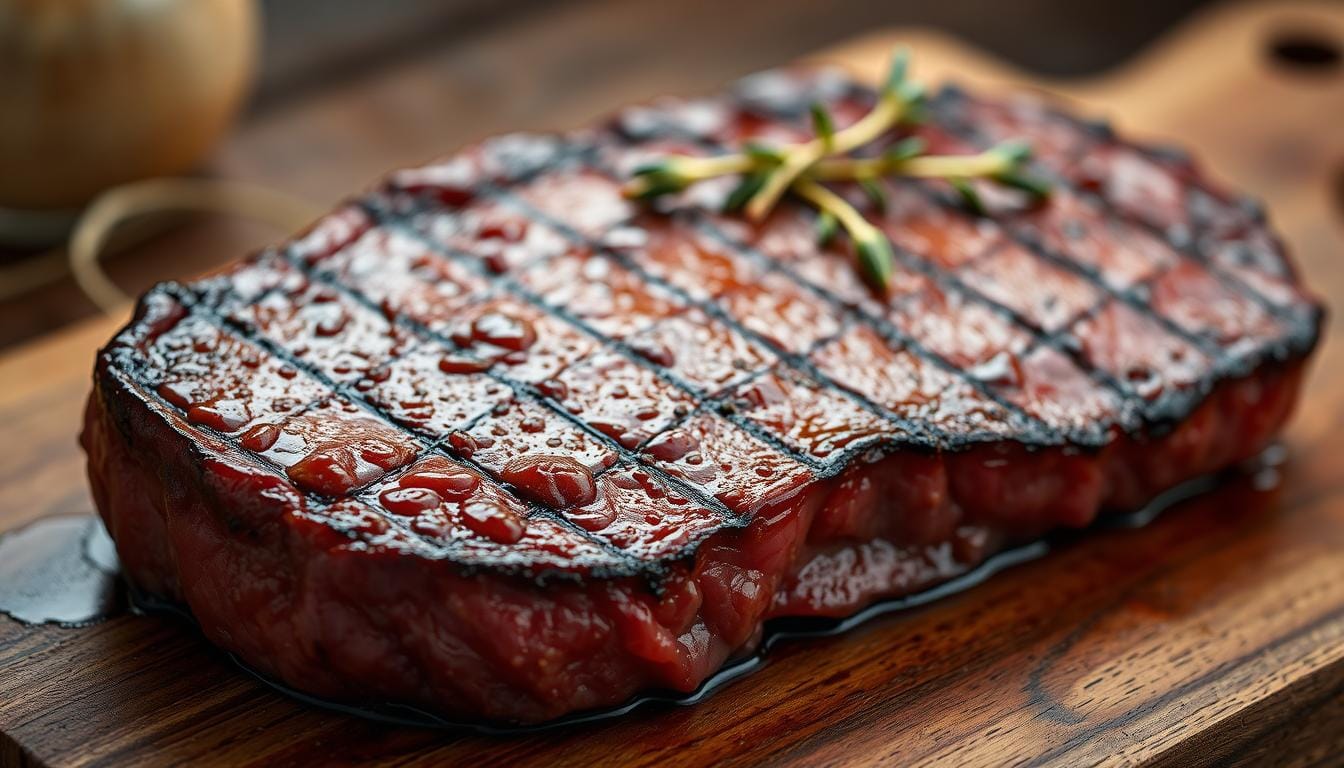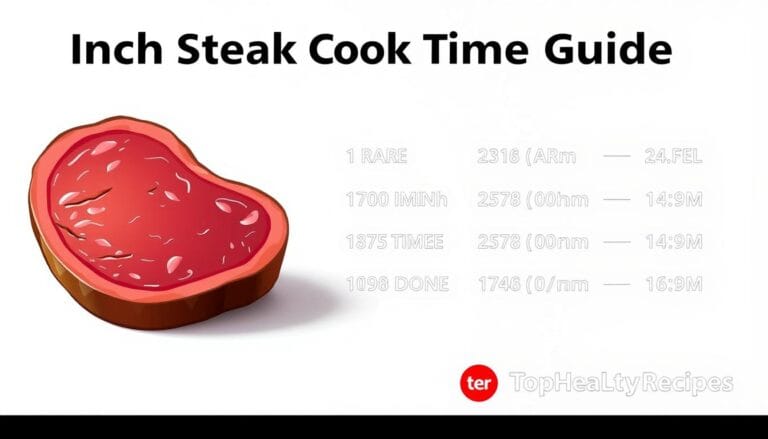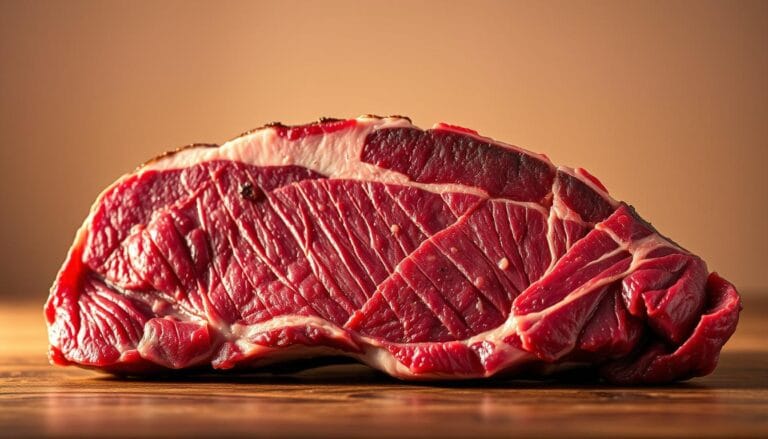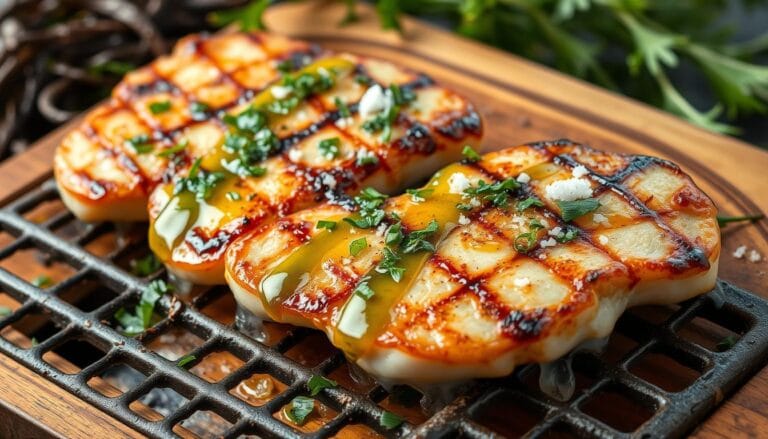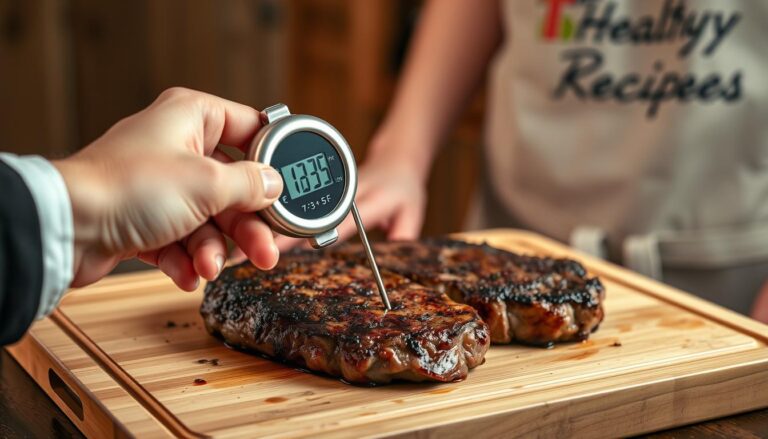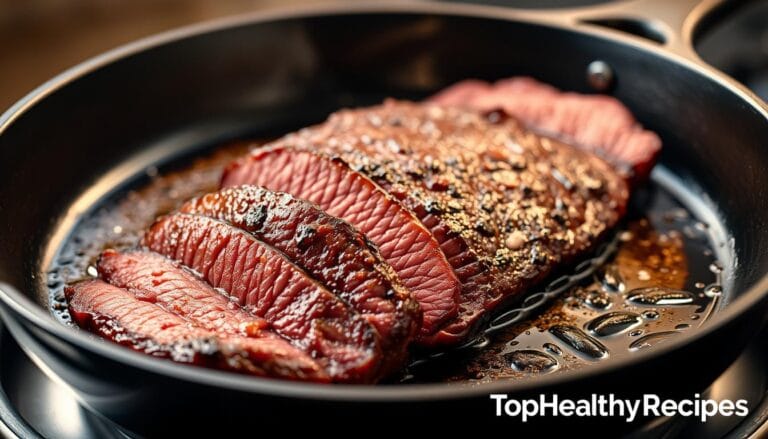Juicy Pan Seared Steak Recipe for a Perfect Crust Every Time
Table of Contents
Juicy Pan Seared Steak Recipe for a Perfect Crust Every Time
Want a steak with a golden crust, just like in fancy restaurants? You can make it at home with a few tricks. Learn how to cook a tasty pan seared steak on your stovetop.
Cooking a great steak is more than just heating it up. It’s about knowing the science for a perfect sear and boosting flavor. This guide will help you, from picking the right cut to getting a crust every time.
Key Takeaways
- Learn how to select the perfect cut for pan searing.
- Understand the science behind achieving a golden-brown crust.
- Discover techniques for enriching your steak’s flavor.
- Master the art of judging doneness without a thermometer.
- Follow a simple, step-by-step guide to cooking steak on the stove.
What is Pan Seared Steak?
Pan searing steak is a simple yet precise technique. It creates a mouth-watering crust and a tender interior. This method uses high heat to make the outside flavorful and the inside juicy.
Understanding the Cooking Technique
Pan searing uses the Maillard reaction. This reaction happens when food is cooked at high temperatures. It creates a perfect crust on the steak.
To do this, preheat your pan to high heat. Add a small amount of oil. Then, sear the steak for a couple of minutes on each side.
Benefits of Pan Searing
Pan searing has many benefits. It’s a favorite among chefs for several reasons:
- Superior Flavor Development: The Maillard reaction makes the flavor rich and savory.
- Cooking in Butter and Aromatics: You can cook the steak in butter and aromatics, adding depth to the dish.
- Better Control Over Doneness: This method lets you control the cooking process. You can ensure your steak is cooked just right.
- Convenience: You can cook steak indoors all year, no matter the weather.
| Benefits | Description |
|---|---|
| Flavor Development | Enhanced flavor through the Maillard reaction |
| Cooking Options | Ability to cook in butter and aromatics |
| Control | Better control over the steak’s doneness |
| Convenience | Indoor cooking, regardless of weather |
Choosing the Right Cut of Steak
Choosing the right steak is key for a great pan-seared crust. Not all steaks are the same for stovetop cooking. Look for a cut with good marbling and thickness.
Popular Cuts for Pan Searing
Popular cuts for pan searing include ribeye, New York strip, filet mignon, and sirloin. Each cut has its own special qualities for pan searing.
- Ribeye: Known for its rich marbling, ribeye is tender and flavorful, making it perfect for pan searing.
- New York Strip: This cut is renowned for its balance of tenderness and flavor, with a firm texture that sears well.
- Filet Mignon: A tender cut, filet mignon is ideal for those looking for a leaner option that also offers great flavor when pan-seared.
- Sirloin: Sirloin steaks are versatile and can be pan-seared to perfection, providing a good balance of flavor and tenderness.
When picking a cut, think about the marbling. It affects the steak’s flavor and tenderness. Opt for cuts with moderate to high marbling for the best results.
How Thickness Affects Cooking
The steak’s thickness is also key for a perfect pan-seared crust. Steaks that are 1 to 1.5 inches thick are usually best for pan searing.
A steak that’s too thin may overcook before getting a good crust. A steak that’s too thick might get burnt on the outside before the inside is cooked right. The key is to find that perfect balance for a nice crust and a juicy inside.
To cook evenly, bring your steak to room temperature before cooking. Also, dry the surface well. This helps get a more even sear.
The Best Seasoning for Steak
Adding the right seasoning to your steak can make a big difference. Even the best steak can be improved with the right flavors. Choosing the right seasonings is key when cooking a steak on the stove.
Classic Seasoning Blends
Classic seasoning blends are a great choice for adding flavor to your steak. Options like Montreal steak seasoning, simple herb blends, and specialty steak rubs are popular. Montreal steak seasoning adds a bold flavor with ingredients like garlic and coriander.
Simple herb blends, like thyme and rosemary, enhance the steak’s natural taste. Timing is important when using these blends. Some should be applied before cooking, while others just before.
The Role of Salt and Pepper
Salt and pepper are essential for great steak. Salt is key for flavor and texture. Different salts, like kosher and sea salt, affect the meat differently.
Pre-salting, or dry brining, helps keep the steak moist and flavorful. It allows salt to penetrate the meat, boosting its taste.
| Seasoning Type | Characteristics | Best Use |
|---|---|---|
| Montreal Steak Seasoning | Robust, garlic-based flavor | Steak cooked on the stove |
| Simple Herb Blends | Complements natural steak flavors | Pan-fried steak |
| Specialty Steak Rubs | Varied flavor profiles | Steak cooked to specific doneness |
Freshly ground black pepper adds a sharpness that pairs well with the steak. Salt and pepper together create a balanced flavor that makes the steak taste better.
Essential Tools for Cooking Steak
The secret to a great pan-seared steak is not just in the ingredients. It’s also about the tools you use. You’ll need the right cookware and utensils to get it just right.
Cookware Needed
The cookware you choose is key for pan-searing steak. A cast iron skillet is often the top choice. It keeps heat well, giving you a perfect sear and crust.
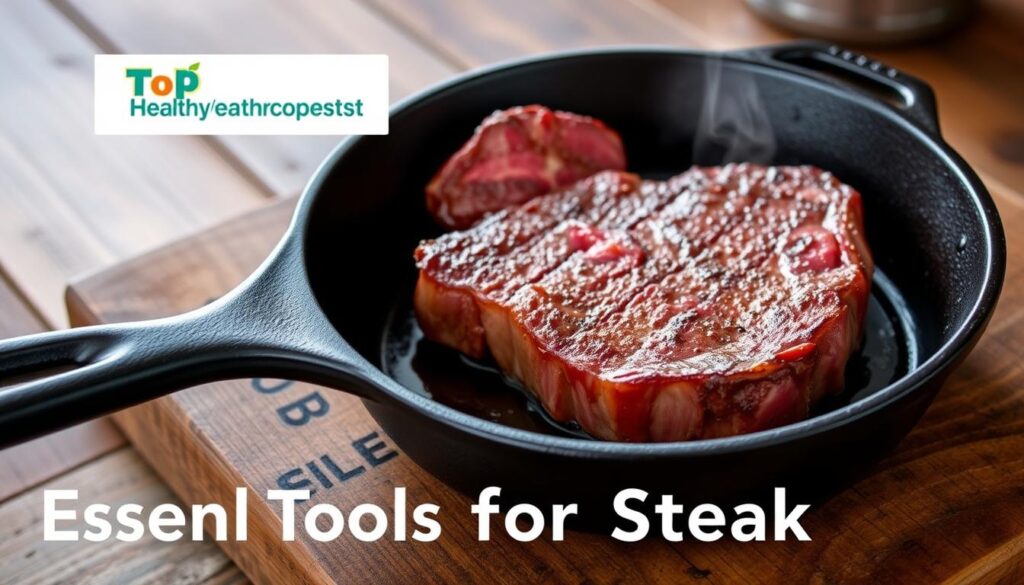
Cast iron skillets are great because they heat up well and stay even. But, they need seasoning to prevent rust and ensure they don’t stick. Make sure your cast iron skillet is well-seasoned before cooking.
Other good options are carbon steel, stainless steel, and heavy-bottomed pans. Carbon steel pans are light and heat well like cast iron. Stainless steel pans are tough but might not keep heat as well. Heavy-bottomed pans spread heat evenly, making them a good choice if you don’t have cast iron or carbon steel.
Must-Have Utensils
Having the right utensils is also key for cooking steak perfectly. Tongs are essential for flipping steak without piercing it. This keeps the juices inside.
- An instant-read thermometer is vital for checking steak doneness. It ensures your steak is cooked just right.
- A timer helps keep track of cooking times, which is helpful if you’re new to steak cooking.
- A splatter screen makes cleanup easier by catching splatters when you add oil or sear the steak.
- Good ventilation in your kitchen is important when cooking at high temperatures. It helps remove smoke and cooking fumes.
Tools like steak weights, butter basters, and specialized spatulas can also be helpful. They can make your cooking process better and help you achieve a perfectly cooked steak.
Preparing Your Steak for Cooking
The secret to a perfectly cooked steak is in the preparation. Many home cooks miss this step. It ensures your steak cooks evenly and gets a nice crust.
Bringing Steak to Room Temperature
Letting your steak warm up before cooking is key. A cold steak can make the outside cook too fast. Take it out of the fridge and let it sit for 30-60 minutes, depending on its thickness.
This helps the steak cook more evenly. A room-temperature steak cooks better, so the outside isn’t overcooked by the time the inside is just right.
| Steak Thickness | Time to Reach Room Temperature |
|---|---|
| 1-1.5 inches | 30 minutes |
| 1.5-2 inches | 45 minutes |
| 2 inches or more | 60 minutes |
Drying the Surface
Drying the steak’s surface is also important. Moisture can make it steam instead of sear, which affects flavor. Pat the steak dry with paper towels on both sides.
Letting the steak rest uncovered in the fridge for a few hours also helps. Some chefs use salt to dry the steak and add flavor.
By preparing your steak this way, you’ll get a better sear and taste. The Maillard reaction, a chemical process, happens when searing. It creates the steak’s unique flavors and aromas.
How to Achieve the Perfect Crust
Getting a perfect crust on a steak is all about the right technique and tools. You need to know about high heat and specific searing methods. This will make your steak tender and crispy.
The Importance of High Heat
High heat is key for a great crust. Your pan should be between 450-500°F for searing. Check if it’s ready by using visual cues or the water droplet test. Keeping the heat steady is also important.
Preheating your pan: A hot pan is essential for a good sear. Test the heat by flicking water on the pan. If it sizzles and evaporates fast, it’s ready.
Techniques for Searing
To get the best sear, move your steak as little as possible. Make sure there’s enough space in the pan. This prevents steaming instead of a nice crust.
- Minimize movement during cooking to allow for a nice crust to form.
- Ensure proper spacing between steaks to prevent steaming.
- Consider the single-flip versus multiple-flip methods to find what works best for you.
| Searing Technique | Description | Benefit |
|---|---|---|
| Single Flip | Flip the steak only once during cooking. | Promotes even browning on both sides. |
| Multiple Flips | Flip the steak multiple times during cooking. | Can help achieve a more uniform crust. |
| Reverse Sear | Cook the steak in a low oven first, then sear in a pan. | Ensures a tender interior and a crispy crust. |
Mastering these techniques and understanding high heat will help you get a perfect crust. Whether you use a cast iron skillet or another pan, keep the heat high and cook with minimal movement.
Cooking Times and Temperatures
To cook a steak on the stove perfectly, focus on cooking times and temperatures. It’s not just about how long you cook it. You also need to reach the right internal temperature.
Doneness Levels and Internal Temperatures
Steak doneness ranges from rare to well-done, with each level having its own temperature range.
- Rare: 120°F – 130°F
- Medium-Rare: 130°F – 135°F
- Medium: 140°F – 145°F
- Medium-Well: 150°F – 155°F
- Well-Done: 160°F – 170°F
A meat thermometer is the best way to check your steak’s internal temperature. You can choose from instant-read digital thermometers or leave-in probe thermometers.
Using a Meat Thermometer
A meat thermometer makes cooking steak easier. Insert it into the thickest part of the steak, avoiding fat or bone. For pan-seared steaks, use an instant-read thermometer to check the temperature after flipping.
Remember carryover cooking, where the steak’s temperature rises after it’s removed from heat. Aim for a temperature a few degrees below your final desired temperature to get the perfect doneness.
| Steak Thickness | Cooking Time (Rare) | Cooking Time (Medium-Rare) |
|---|---|---|
| 1 inch | 4-6 minutes | 6-8 minutes |
| 1.5 inches | 6-8 minutes | 8-10 minutes |
Cooking times can change based on the steak’s thickness and your stove’s heat. But, a thermometer ensures your steak is always cooked just right.
Tips for Resting Steak After Cooking
Letting your steak rest is key to a perfect pan seared steak. It’s tempting to serve it right away after searing. But, skipping this step can make your steak less juicy and tender.
The Science Behind Resting
Resting your steak is important because it relaxes the muscle fibers. When you cook a steak, the heat tightens the proteins, pushing juices to the surface. Cutting into it right away lets these juices spill out.
By resting, the proteins relax and juices spread evenly. This makes your steak more tender and flavorful.
Resting is not just about patience; it’s about improving your steak’s quality. It ensures your steak stays juicy and tender when you slice it.
Proper Techniques for Resting Steak
To rest your steak, first take it off the heat. Then, put it on a wire rack or plate, covered loosely with foil. The resting time depends on the steak’s thickness, usually 5 to 10 minutes. For a standard cut, 5 minutes is enough.
The resting environment also matters. Foil helps keep the steak warm but can make the crust soft. You need to find a balance to keep the steak warm and the crust intact.
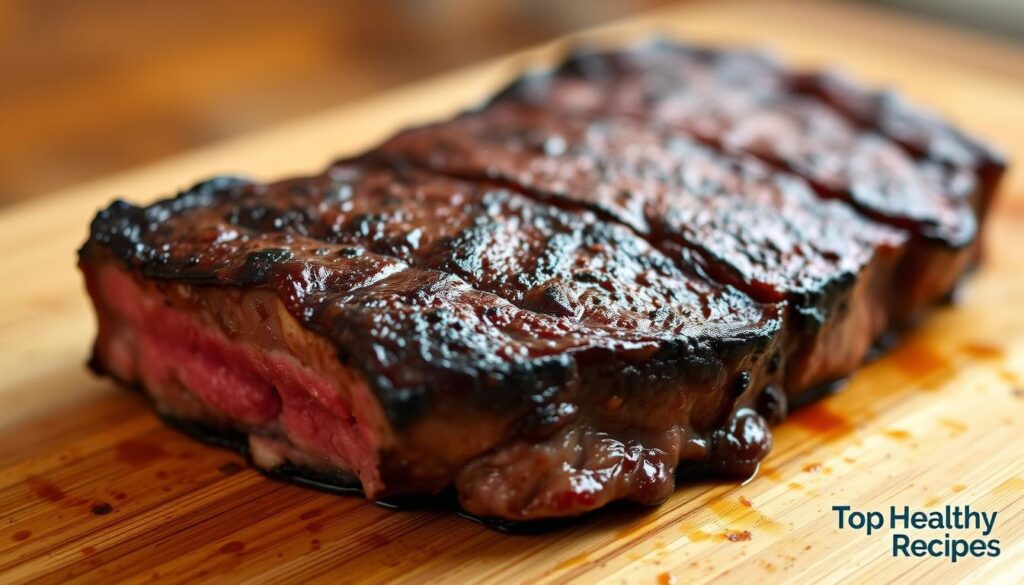
Some chefs use active resting techniques, like melting butter over the steak or warming it in a low oven. These methods add flavor and keep the steak at a good temperature without overcooking.
Adding a proper resting period to your cooking routine will greatly enhance your pan seared steak. It makes for a more enjoyable and satisfying meal.
Enhancing Flavor with Butter and Aromatics
Adding butter and aromatics to your pan-seared steak can make it taste better. This method adds richness and depth to the steak’s natural flavors. It makes the dish more enjoyable to eat.
Richness with Butter
Butter is key to making your steak taste amazing. When you add it towards the end, it bastes the steak, making it tender and juicy. It also creates a flavorful crust. The trick is to add the butter at the perfect time.
- Use about 1-2 tablespoons of butter for a typical serving.
- Clarified butter is a good option because it doesn’t burn easily.
- Tilt the pan and spoon the melted butter over the steak to coat it evenly.
For a special treat, try pairing your steak with shrimp. Check out recipes like shrimp on steak for a surf-and-turf dish.
Infusing with Aromatics
Aromatics like garlic, fresh herbs, shallots, and citrus zest can add subtle flavors to your steak. It’s important to prepare them right to get the most flavor without burning.
- Crush garlic cloves to release their oils and flavor.
- Chop fresh herbs finely so they release their flavors when heated.
- Sauté aromatics in the pan before adding the steak to create a flavorful base.
Some great pairings include garlic and rosemary with a ribeye or thyme with a filet mignon. Try different aromatics to find the perfect match for your steak.
Serving Suggestions for Pan Seared Steak
A perfectly cooked pan seared steak is just the start of a great meal. To make your steak dinner unforgettable, think about what sides to serve.
There are many side dishes you can choose from. Classic choices like creamy mashed potatoes or roasted vegetables are great. They enhance the steak without taking over. For something new, try grain bowls, polenta, or fresh vegetable dishes. They bring a modern twist to your steak dinner.
### Ideal Pairings for Side Dishes
Ideal Pairings for Side Dishes
Choosing the right side dish is all about balance. For a ribeye, a crisp salad with tangy dressing is refreshing. A hearty grain bowl with roasted veggies is perfect for a filet mignon.
- Roasted vegetables
- Creamy mashed potatoes
- Crisp salads
- Grain bowls
- Polenta
Culinary expert says, “Pairing steak with side dishes is about harmony on the plate.”
“The art of pairing steak with side dishes is about creating harmony on the plate.” -Chef’s quote
### Recommended Sauces and Toppings
Recommended Sauces and Toppings
Sauces and toppings can make your steak even better. Classic choices likecompound butters,béarnaise, andpeppercorn sauce are always a hit. But, you can also try new flavors likechimichurri,flavored oils, andgourmet salts. The trick is to pick something that matches your steak’s flavor and doneness.
For instance, a peppercorn sauce goes well with a well-done ribeye. A chimichurri adds a fresh, herby taste to a medium-rare filet mignon. Don’t be afraid to mix and match to find your favorite.
| Sauce/Topping | Steak Cut | Doneness |
|---|---|---|
| Peppercorn sauce | Ribeye | Well-done |
| Chimichurri | Filet mignon | Medium-rare |
| Béarnaise | New York strip | Medium |
Storing Leftover Pan Seared Steak
After enjoying a perfectly cooked pan-seared steak, you may have leftovers. It’s important to store them right to keep the steak fresh. When cooking steak on the stove, like in a best cast iron skillet steak, the leftovers can stay good with proper storage.
Cooling and Storage
Cool the steak to room temperature within two hours of cooking. Then, wrap it tightly in plastic wrap or aluminum foil. Store it in an airtight container in the fridge at 40°F (4°C) or below.
Reheating Leftovers
To reheat your leftover steak, use a gentle oven warming method or sous vide. This helps keep the steak moist. You can also slice the steak thinly and add it to salads or sandwiches for a quick meal. When reheating, make sure the steak reaches an internal temperature of 165°F (74°C) for food safety.
FAQ
What is the best type of pan for pan searing steak?
How do I achieve a perfect crust on my pan-seared steak?
What is the ideal thickness for a steak to be pan-seared?
How do I know when my steak is cooked to the right doneness?
Can I use a non-stick pan for pan searing steak?
How long should I let my steak rest after cooking?
What are some common mistakes to avoid when pan searing steak?
Can I add aromatics like garlic and herbs to the pan while cooking steak?
For more cooking tips, stay connected with us. We also recommend the cookbook Skinnytaste Simple: Easy, Healthy Recipes with 7 Ingredients or Fewer
For more Recipes about Steak ?
Did You try our recipe ?
There are no reviews yet. Be the first one to write one.
